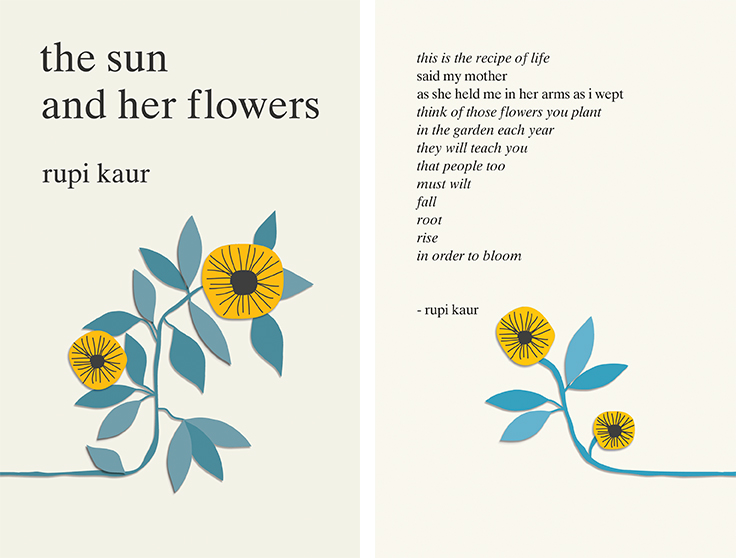Photos by Nabil Shash and John Halper
The perception of poetry in modern society is that this literary form fell off sometime after the 19th century. But the truth is, poetry is just as prominent now as it was back then. It may not bare the same rhyme scheme or rhythmic structure of Wordsworth, and poets themselves don’t resemble the age, race or class of their popular predecessors; but Rupi Kaur, a 25-year-old Punjabi-Canadian woman, has been able to do what no one else has done before her—become a poetry phenomenon.
Despite not having won any awards or been appointed any titles, Kaur is the best-selling poet of our generation, and maybe ever. Her first book, “Milk and Honey,” has sold over 2.5 million copies worldwide since its 2014 release and spent 78 weeks on The New York Times Trade Paperback Best-Seller list. For comparison, it beat out Homer’s “The Odyssey” which was once considered the highest grossing book of all time. Her social media following alone is akin to that of the Hollywood elite, nearing two million in total, which is utterly unheard of for any literary figure past or present. So what is it about Kaur and her work that speaks to the masses? Some would say it’s her ability to connect.
After posting her prose, short-form poetry and artwork on Tumblr in 2012, Kaur knew she had an audience. It wasn’t big, but there was a group of South Asian women who took to her. She wasn’t writing about romance, life or love—Kaur was writing about troubling issues that few before her have dared to explore: violence, sexual abuse and trauma. What didn’t happen directly to her, she witnessed personally afflict members of her own family.
In “Milk and Honey,” Kaur gave a voice to the Indian women who aren’t allowed to have one. But something else happened too—something much more unexpected. Kaur tapped into the human experience and the world was standing by, watching and waiting.
At any stop on her tour, expect a line. Not a line outside of a corner bookstore or coffee shop but an arena. And don’t think that it will be quiet or subdued, listen for the roars of her followers. Some will likely have her lyrics tattooed upon their bodies, others will recite Kaur’s own words back to her in tandem. It is the equivalent of seeing your favorite artist in concert but one that touches on every facet of your being. In one sitting, Kaur will make you laugh, smile, and oftentimes, bring you to tears.
Her poetry in itself doesn’t ask for a lot, which is why it’s so well-received and also highly criticized. Her minimalist style and simplistic language doesn’t challenge you in the ways that you’ve been taught traditional poetry should. Kaur is straightforward in her delivery, precise with her words and relatable in her sentiments. And after a three year hiatus, she has finally made her long-awaited return with “The Sun and Her Flowers”—a project Kaur told Interview Magazine’s Rebecca Szkutak she started working on the same day her first book came out.
“Between 2014 and now, there was a long period I wasn’t writing, because when ‘Milk and Honey’ really hit off I was touring so much and I kind of lost that relationship with my art, and because I wasn’t present enough to practice it everyday. But I’ve been writing since then, a heavy chunk of this year and last year has been focused on putting it all together, and it was months of waking up everyday and writing until I go to sleep.”
At a glance, “The Sun and Her Flowers” is everything you’d expect from Kaur. Admirers will over pine over the intricacies of her line drawings. The poems themselves are still lowercase, punctuation-less and small enough to fit the shape of your screen. But this time, instead of “the hurting”, “the loving”, “the breaking” and “the healing” — Kaur focuses on the “wilting”, “falling”, “rooting”, “rising”, and “blooming”.
 What’s different is that Kaur isn’t asking you to look inside yourself, she’s asking you instead to look out into the world. “The Sun and Her Flowers” considers things like life, loss and loneliness with a maturity and wisdom that “Milk and Honey” could not. It reflects the ways in which Kaur herself has grown as a writer, artist, poet and woman. She explained to Szkutak, “I never thought that I would write about family and now there’s an entire chapter in this book about family, and I never had the tools to do that before. I never thought I’d write poems about death, or these broad-like spectrum poems but I was able to get to a place where they kind of, sort of just came naturally.” Kaur also touches upon themes like immigration, feminism, Sikh genocide and what it means to grow up with English as your second language.
What’s different is that Kaur isn’t asking you to look inside yourself, she’s asking you instead to look out into the world. “The Sun and Her Flowers” considers things like life, loss and loneliness with a maturity and wisdom that “Milk and Honey” could not. It reflects the ways in which Kaur herself has grown as a writer, artist, poet and woman. She explained to Szkutak, “I never thought that I would write about family and now there’s an entire chapter in this book about family, and I never had the tools to do that before. I never thought I’d write poems about death, or these broad-like spectrum poems but I was able to get to a place where they kind of, sort of just came naturally.” Kaur also touches upon themes like immigration, feminism, Sikh genocide and what it means to grow up with English as your second language.
On its own, “The Sun and Her Flowers” lives up to the hype. It may not have reached coffee-table status like its sister just yet, but Kaur’s second coming promises nothing less than a journey through raw, untapped emotion. Since her rise to fame as “Instapoet”, Kaur has only further ignited a new generation of young creatives who, like her, challenge criticism, push boundaries and define their own versions of freedom.
MORE Lifestyle STORIES
Get an inside vue on the latest in luxury. You heard it here first.



